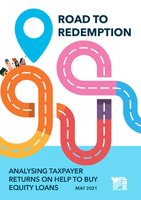Government home ownership scheme sees strong returns for taxpayers
Analysis of Help to Buy repayments shows Exchequer generating more than 10% return on investment
New analysis of household repayments under the Help to Buy Equity Loan scheme shows that the Government’s home ownership scheme has seen homeowners repay their Government equity loans with an average uplift of more than 10% when compared with the original loan value.
Housing Secretary, Robert Jenrick recently announced that the scheme which opened in 2013, has now supported more than 300,000 homebuyers to purchase a new build home, with more than four in five purchasers being First-Time Buyers. Today’s report, The Road to Redemption now details how the first 49,000 equity loan redemptions generated a £232 million return on investment as a growing number of homeowners continue to pay back the Government in ever larger numbers.
The research, conducted by the Home Builders Federation, reveals that:
- The Government has received £2.481bn in repayments of loans with an original value of £2.249bn, a return of £232m
- Up to March 2020, 49,020 Help to Buy Equity Loans had been fully redeemed, 18% of all the loans issued up to that point
- 60% of equity loans issued in the first two years of the scheme (2013/14 and 2014/15) were fully repaid by March 2020
- During 2019/20, the Exchequer received £941m in repayments of loans with an original value of £875m, an increase of £66m
The report also highlights the link between the introduction of the scheme and the rapid increase in housing supply seen in England since 2014, detailing how strong the new build housing market has been relative to the second-hand market. By early 2020, annual new build transactions were back to roughly the same number as those recorded before the financial crisis of the late 2000s. In the secondary market, however, transactions were still some 30% short of historic figures.
Under the Help to Buy scheme, homebuyers can receive an equity loan from the Government, allowing them to purchase a new build home with a deposit of just 5% of the property’s value. The equity loan is interest free for the first five years. The maximum value of the equity loan is 20% of the value of the home, with a higher maximum of 40% in London. Since April 2021, the £600,000 national price cap for the scheme has been replaced with regional caps ranging from £186,100 in the North East to £600,000 in London.
Commenting on the research, HBF’s Executive Chairman, Stewart Baseley said:
“For many years we have heard first hand of the impact that Help to Buy has had in turning the dream of home ownership into a reality for so many households and we have seen evidence of the link between the scheme and the additional investment by home builders which has driven rapid housing supply increases. Now we can also see that the scheme is contributing to public finances as homebuyers pay back Government support”
- ENDS -
For media enquiries, or to arrange an interview, please contact Steve Turner – 07919 307760 or steve.turner@hbf.co.uk
Notes to editors
- Help to Buy key facts
- Help to Buy launched in April 2013. The first programme ended in March 2021 and has been replaced with a new Help to Buy scheme exclusive to first-time buyers and with regional price caps. The current scheme closes formally in March 2023 but final sales under the scheme will need to be made before the end of 2022.
- In 2020, the median price of a property purchased with Help to Buy support was £279,995 outside of London and £445,000 in the capital
- 73% of Help to Buy completions have had a sales price of under £350,000
- 87% of Help to Buy purchasers had a combined household income of under £80,000. This compares with the £80,000 or £90,000 maximum income for Affordable Housing products such as Shared Ownership
- Outside of London, during 2020 the median household income for a purchasing household was £54,482
- 82% of homes purchased with the scheme to date have been houses
- The local authority areas in which the most First-Time Buyers have used Help to Buy to get on the housing ladder are (up to the end of Dec 2020):
- Wiltshire (3,450)
- Central Bedfordshire (3,384)
- Wakefield (3,383)
- Leeds (3,168)
- County Durham (3,045)
- Milton Keynes (2,918)
- Cheshire East (2,688)
- Peterborough (2,426)
- Bedford (2,383)
- Cheshire West and Cheshire (2,313)
- South Gloucestershire (2,306)
- Birmingham (2,288)
- Aylesbury Vale (2,176)
- Wigan (2,108)
- Wokingham (2,107)
- Cornwall (2,075)
- Telford and Wrekin (2,064)
- London Borough of Barnet (2,061)
- Manchester (2,028)
20. Liverpool (1,951)
- Housing supply
- In the year before Help to Buy launched, England recorded the lowest ever annual net housing supply figure during peacetime (124,000). By 2019/20, this had risen to 244,000
- The 244,000 net additions in 2019/20 surpasses the average annual net supply recorded during the 1950s (215,000 per year) and the 1960s (243,000 per year)
- HBF
The Home Builders Federation (HBF) is the representative body of the home building industry in England and Wales. The HBF’s member firms account for some 80% of all new homes built in England and Wales in any one year, and include companies of all sizes, ranging from national, developers through regionally based businesses to small local companies. Private sector homebuilders are also significant providers of affordable homes, building 52% of all affordable homes in 2019/20.

